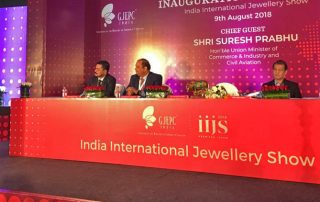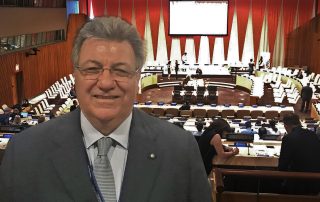CIBJO releases Marketing & Education Special Report, considers impact on jewellery market of Generation Z
August 15, 2018
With fewer than nine weeks to go to the opening of the 2018 CIBJO Congress in Bogotá, Colombia, on October 15, 2018, the first of the CIBJO commissions’ Special Reports has been released. Prepared by the CIBJO Marketing & Education Commission, headed by Jonathan Kendall, the report considers the potential impact on the jewellery market of Generation Z, which includes people born after 1996, who are expected to account for about 40 percent of all consumers by 2020.
“For we the jewellery industry, it is essential to adapt strategies if we hope to succeed with Generation Z,” writes Mr. Kendall. “Gone are the old media approaches of TV commercials, long-term PR plans and static messaging. Today it’s all about fast delivery of interactive messages.”
Studies indicate the members of Generation Z rely on the advice of their peers, who may be located in multiple locations, meaning that jewellers have to create products that have global appeal. They are also more conservative and risk averse that the generation of millennials that precede them, but at the same time are decidedly socially and environmentally conscious.
“We need to show we care, because they very much care,” notes Mr. Kendall. “We must be clear about what we stand for, so our that businesses, brands and products are not interpreted as being uninvolved, or, even worse, opposed to the social causes that are important to Gen Z.”
To download a full copy of the CIBJO Market & Education Commission’s special report, PLEASE CLICK HERE.
CIBJO President pledges support for Indian jewellery industry, during IIJS opening ceremony in Mumbai
ABOVE: CIBJO President Gaetano Cavalieri addressing the opening ceremony of the India International Jewellery. He is joined at podium by (from right) Sabyasachi Ray, GJEPC Executive Director; Pramod Agarwal, GJEPC Chairman; Colin Shah, GJEPC Vice Chairman; and Shailesh Sangani, Convenor of GJEPC’s National Exhibition Sub-Committee.
August 9, 2018
CIBJO President Gaetano Cavalieri has pledged CIBJO’s support for India’s giant jewellery and gemstone sectors, during the opening ceremony of the summer edition of the India International Jewellery Show (IIJS), which took place at the Bombay Exhibition Centre this morning.
The massive jewellery and gemstone trade fair, which is organised by the Indian industry’s primary trade organization, the Gem & Jewellery Export Promotion Council (GJEPC), will run through August 13, and attract some 1,500 exhibitors in multiple pavilions, and tens of thousands of professional attendees, from 800 cities and towns across the country and from more than 80 countries.
The CIBJO President was a guest of honour at the opening ceremony, where together with the GJEPC leadership he participated in a traditional candle-lighting ceremony, led by the council’s Chairman, Pramod Agarwal.


GJEPC Chairman Pramod Agarwal (left) lighting a candle during the opening ceremony of the India international Jewellery Show, as GJEPC Council Vice Chairman Colin Shah (centre), GJEPC Executive Director Sabyasachi Ray (second from right) and CIBJO President Gaetano Cavalieri look on.
Addressing the assembled gathering, Dr. Cavalieri congratulated the GJEPC for its ongoing work in the development and promotion of the Indian gemstone and jewellery sector, which today is the world’s overwhelmingly dominant centre for the processing of gemstones and jewellery, and also is its third largest national jewellery consumer market.
It is in particular the growing importance of India’s domestic market that is reflected in the emergence of the IIJS August show as a major fixture of the global jewellery sectors annual calendar, he stated. “India has been a critically important player in our industry for decades already, but initially was regarded predominantly as a production centre. Today it is a one of a handful of countries, together with the United States and China, whose presence is felt in all stages of the chain of distribution, both driving and satisfying demand,” Dr. Cavalieri said.
“But not only is India important to our industry, our industry is critical to India, contributing about 7 percent of its GDP, about 16 percent of its total merchandise exports, and employing more than 4.64 million workers. With almost 18 percent of the world’s population, India is a country that conclusively demonstrates that, while precious gemstones and jewellery may be non-essential luxury items, the jewellery and gemstone industry is an indispensable part of the global economy.”
CIBJO participating in ECOSOC High-Level Segment, its statement on jewellery sector circulated by council
ABOVE: Gaetano Cavalieri, President of CIBJO, against the backdrop of the 2018 High-Level Segment of the United Nations Economic and Social Council (ECOSOC) in New York.
July 17, 2018
CIBJO President Gaetano Cavalieri is participating in the annual High-Level Segment of the Economic and Social Council (ECOSOC) currently underway in New York, where just prior to the meeting the council’s Secretary General approved and distributed a statement on the jewellery industry’s contribution to the UN development programme that had been submitted by the World Jewellery Confederation.
The three-day ECOSOC gathering that began on July 16 represents the culmination of ECOSOC’s annual cycle of work, and convenes a diverse group of senior representatives from government, private sector, civil society and academia for policy dialogue, review and recommendations on the 2030 Agenda for Sustainable Development, as well as other international development goals. The theme of this year’s session is “From global to local: supporting sustainable and resilient societies in urban and rural communities.”
CIBJO has been the international jewellery and gemstone sector’s first and only representative in ECOSOC since 2006, when it was awarded special consultative status.
Echoing the 2018 ECOSOC High-Level Segment theme, the CIBJO statement referred to projects being taken both under its own auspices and in the greater jewellery sector. “CIBJO’s strategy has been developing educational programmes, initiating and/or supporting industry efforts, and creating tools and platforms for member organisations in their respective countries. The underlying premise of this approach is that progress will result from an aggregation of multiple grass-roots efforts,” it noted.
Among the specific programmes mentioned in the CIBJO statement are the World Jewellery Confederation’s own Jewellery Industry Greenhouse Gas Measurement Initiative, which helps companies understand, reduce and offset their carbon footprints. Other programmes cited include a rutilated quartz mine in Brazil that seeks to implement a model using natural resources as the foundation for sustainable development, the Jewellery Development Impact Index, whose concept CIBJO helped create at the Jewellery Summit in Tucson in 2017, and is today housed within the Minerals, Materials and Society programme at the University of Delaware in the United States. Also mentioned is a plan that was first presented last year at the Oceans Conference at the United Nations in New York, which was attended by the CIBJO president, involving the development of a sustainable pearl farming sector in Fiji, which includes responsibly-managed marine pearling areas that also create income-generating opportunities for indigenous communities.
“The World Jewellery Confederation supports the implementation of the Sustainable Development Goals (SDG) through its work, with special emphasis on grass-roots projects in the jewellery and gemstone sectors. Involving several partners, it calls for transparency and inclusiveness, and strengthening local and global partnerships,” CIBJO noted in its statement to ECOSOC.
To download a copies of the statement from CIBJO circulated by ECOSOC, please click one of the following links:




